NUR1102 - Mrs. Pamela Jones Case Study: Therapeutic Communication
VerifiedAdded on 2022/09/26
|7
|2012
|27
Essay
AI Summary
This essay presents a detailed analysis of the Mrs. Pamela Jones case study, focusing on the application of therapeutic communication in nursing practice. The essay begins by identifying instances of ineffective communication between the nurse and the patient, highlighting the impact on the patient's well-being and the establishment of a therapeutic relationship. It then explores the concept of compassion as a crucial element of nursing care, emphasizing its role in fostering trust and understanding with patients experiencing confusion and disorientation. The essay further examines specific strategies, skills, and approaches, such as active listening and offering oneself, that can best support therapeutic communication between nurses, patients, and their families, leading to improved patient outcomes. Finally, the essay reflects on the student's emerging health literacy skills, emphasizing the importance of therapeutic communication in nursing and its impact on the nurse-patient relationship. The conclusion reiterates the significance of effective communication and the use of various therapeutic communication skills in meeting the needs of patients.
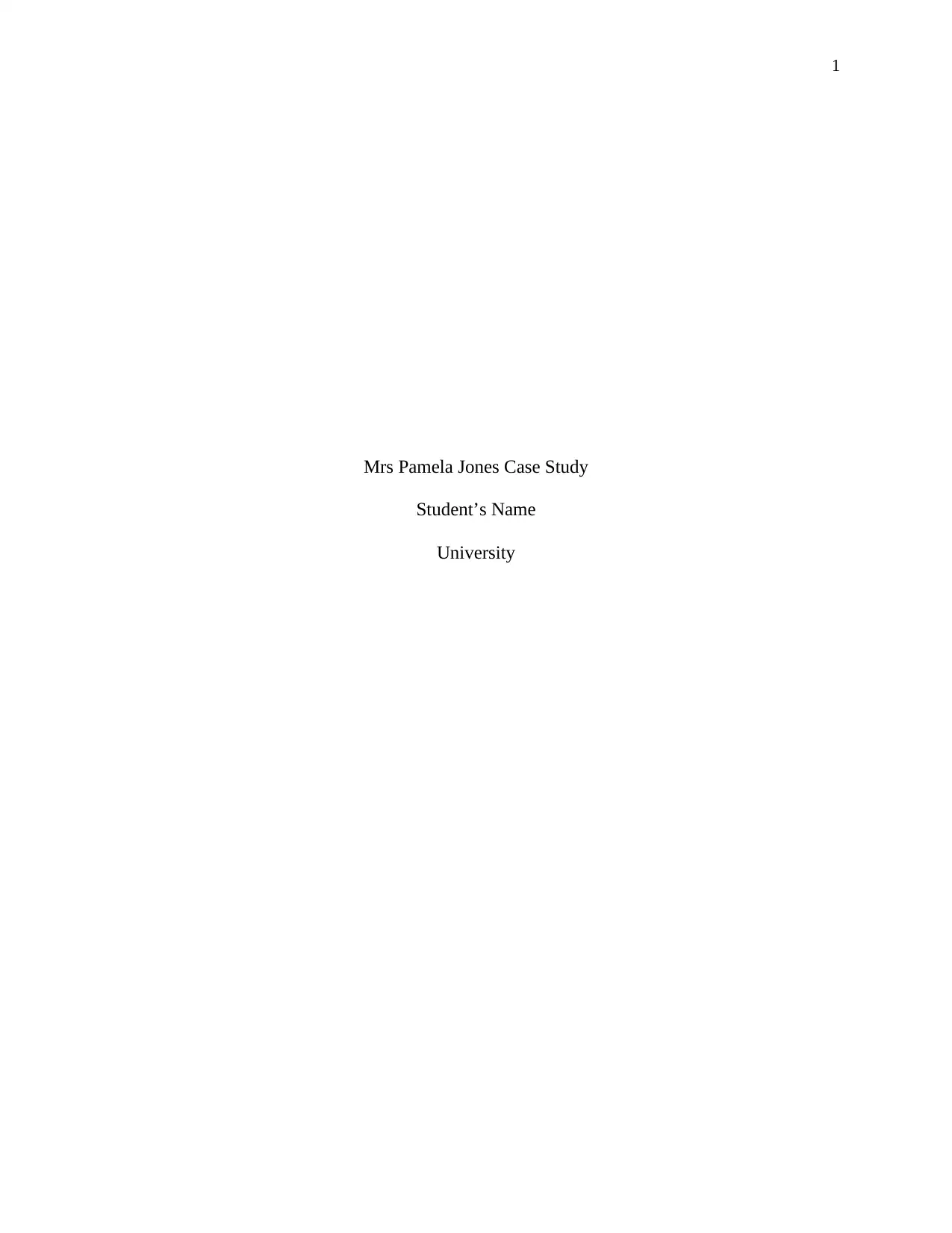
1
Mrs Pamela Jones Case Study
Student’s Name
University
Mrs Pamela Jones Case Study
Student’s Name
University
Paraphrase This Document
Need a fresh take? Get an instant paraphrase of this document with our AI Paraphraser
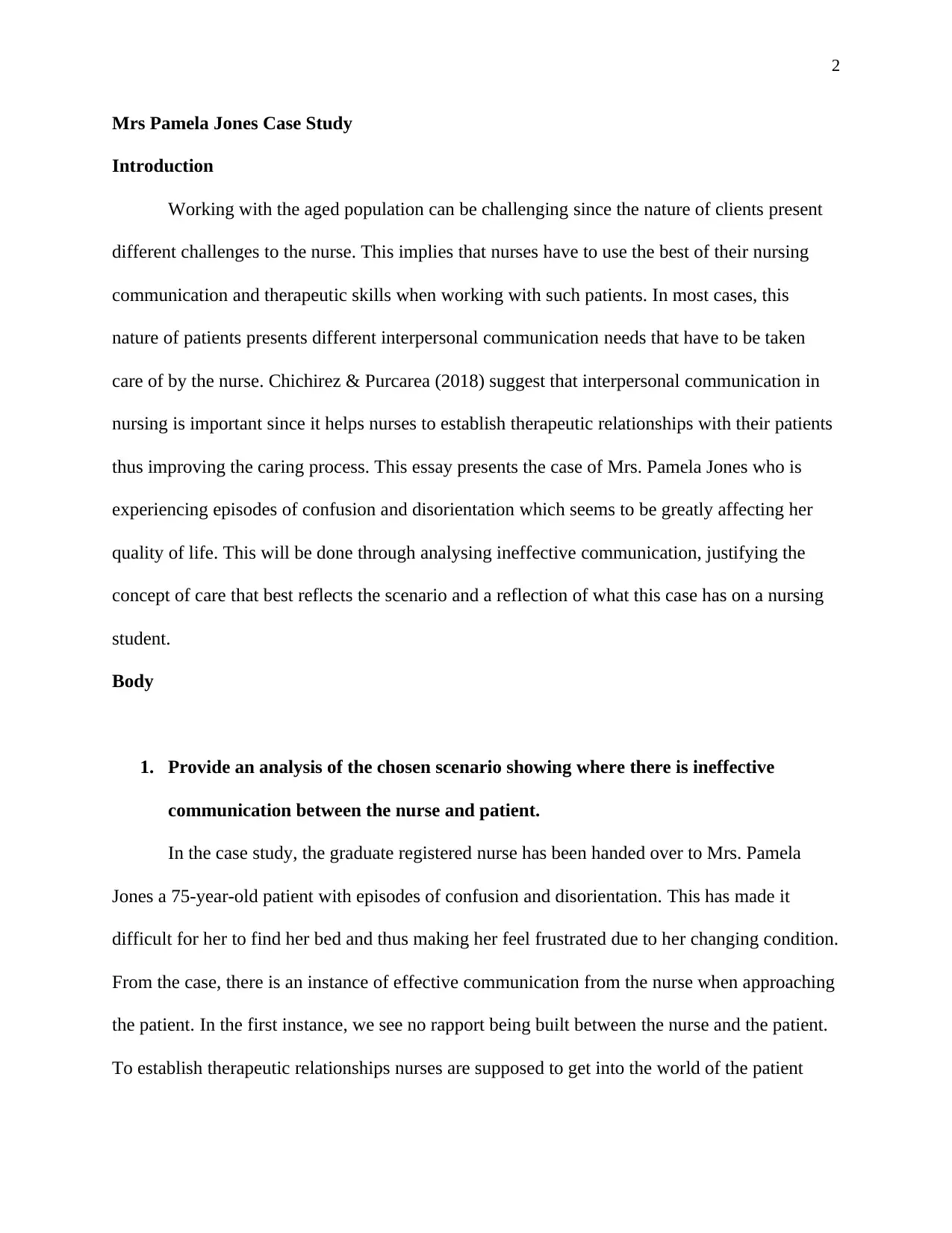
2
Mrs Pamela Jones Case Study
Introduction
Working with the aged population can be challenging since the nature of clients present
different challenges to the nurse. This implies that nurses have to use the best of their nursing
communication and therapeutic skills when working with such patients. In most cases, this
nature of patients presents different interpersonal communication needs that have to be taken
care of by the nurse. Chichirez & Purcarea (2018) suggest that interpersonal communication in
nursing is important since it helps nurses to establish therapeutic relationships with their patients
thus improving the caring process. This essay presents the case of Mrs. Pamela Jones who is
experiencing episodes of confusion and disorientation which seems to be greatly affecting her
quality of life. This will be done through analysing ineffective communication, justifying the
concept of care that best reflects the scenario and a reflection of what this case has on a nursing
student.
Body
1. Provide an analysis of the chosen scenario showing where there is ineffective
communication between the nurse and patient.
In the case study, the graduate registered nurse has been handed over to Mrs. Pamela
Jones a 75-year-old patient with episodes of confusion and disorientation. This has made it
difficult for her to find her bed and thus making her feel frustrated due to her changing condition.
From the case, there is an instance of effective communication from the nurse when approaching
the patient. In the first instance, we see no rapport being built between the nurse and the patient.
To establish therapeutic relationships nurses are supposed to get into the world of the patient
Mrs Pamela Jones Case Study
Introduction
Working with the aged population can be challenging since the nature of clients present
different challenges to the nurse. This implies that nurses have to use the best of their nursing
communication and therapeutic skills when working with such patients. In most cases, this
nature of patients presents different interpersonal communication needs that have to be taken
care of by the nurse. Chichirez & Purcarea (2018) suggest that interpersonal communication in
nursing is important since it helps nurses to establish therapeutic relationships with their patients
thus improving the caring process. This essay presents the case of Mrs. Pamela Jones who is
experiencing episodes of confusion and disorientation which seems to be greatly affecting her
quality of life. This will be done through analysing ineffective communication, justifying the
concept of care that best reflects the scenario and a reflection of what this case has on a nursing
student.
Body
1. Provide an analysis of the chosen scenario showing where there is ineffective
communication between the nurse and patient.
In the case study, the graduate registered nurse has been handed over to Mrs. Pamela
Jones a 75-year-old patient with episodes of confusion and disorientation. This has made it
difficult for her to find her bed and thus making her feel frustrated due to her changing condition.
From the case, there is an instance of effective communication from the nurse when approaching
the patient. In the first instance, we see no rapport being built between the nurse and the patient.
To establish therapeutic relationships nurses are supposed to get into the world of the patient
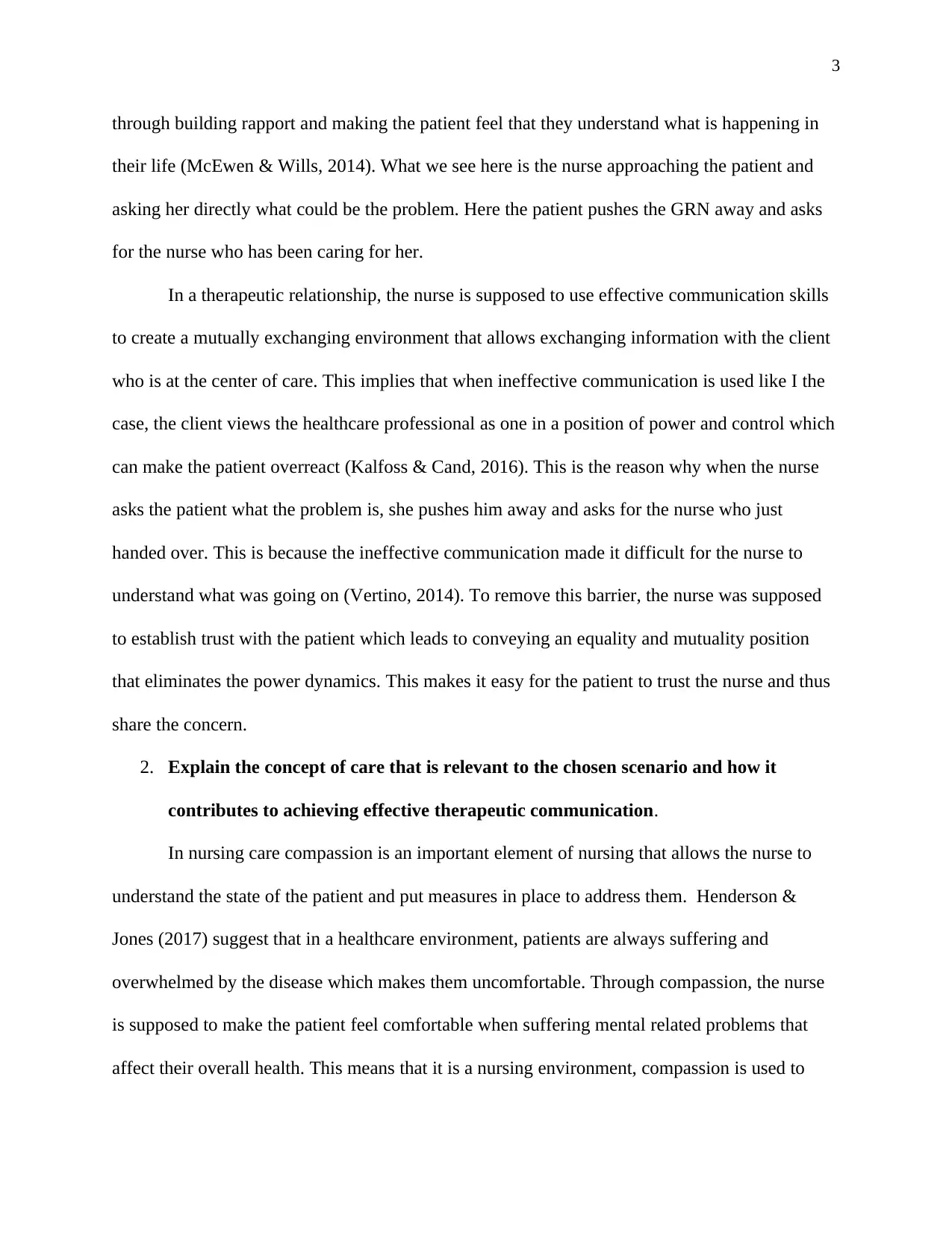
3
through building rapport and making the patient feel that they understand what is happening in
their life (McEwen & Wills, 2014). What we see here is the nurse approaching the patient and
asking her directly what could be the problem. Here the patient pushes the GRN away and asks
for the nurse who has been caring for her.
In a therapeutic relationship, the nurse is supposed to use effective communication skills
to create a mutually exchanging environment that allows exchanging information with the client
who is at the center of care. This implies that when ineffective communication is used like I the
case, the client views the healthcare professional as one in a position of power and control which
can make the patient overreact (Kalfoss & Cand, 2016). This is the reason why when the nurse
asks the patient what the problem is, she pushes him away and asks for the nurse who just
handed over. This is because the ineffective communication made it difficult for the nurse to
understand what was going on (Vertino, 2014). To remove this barrier, the nurse was supposed
to establish trust with the patient which leads to conveying an equality and mutuality position
that eliminates the power dynamics. This makes it easy for the patient to trust the nurse and thus
share the concern.
2. Explain the concept of care that is relevant to the chosen scenario and how it
contributes to achieving effective therapeutic communication.
In nursing care compassion is an important element of nursing that allows the nurse to
understand the state of the patient and put measures in place to address them. Henderson &
Jones (2017) suggest that in a healthcare environment, patients are always suffering and
overwhelmed by the disease which makes them uncomfortable. Through compassion, the nurse
is supposed to make the patient feel comfortable when suffering mental related problems that
affect their overall health. This means that it is a nursing environment, compassion is used to
through building rapport and making the patient feel that they understand what is happening in
their life (McEwen & Wills, 2014). What we see here is the nurse approaching the patient and
asking her directly what could be the problem. Here the patient pushes the GRN away and asks
for the nurse who has been caring for her.
In a therapeutic relationship, the nurse is supposed to use effective communication skills
to create a mutually exchanging environment that allows exchanging information with the client
who is at the center of care. This implies that when ineffective communication is used like I the
case, the client views the healthcare professional as one in a position of power and control which
can make the patient overreact (Kalfoss & Cand, 2016). This is the reason why when the nurse
asks the patient what the problem is, she pushes him away and asks for the nurse who just
handed over. This is because the ineffective communication made it difficult for the nurse to
understand what was going on (Vertino, 2014). To remove this barrier, the nurse was supposed
to establish trust with the patient which leads to conveying an equality and mutuality position
that eliminates the power dynamics. This makes it easy for the patient to trust the nurse and thus
share the concern.
2. Explain the concept of care that is relevant to the chosen scenario and how it
contributes to achieving effective therapeutic communication.
In nursing care compassion is an important element of nursing that allows the nurse to
understand the state of the patient and put measures in place to address them. Henderson &
Jones (2017) suggest that in a healthcare environment, patients are always suffering and
overwhelmed by the disease which makes them uncomfortable. Through compassion, the nurse
is supposed to make the patient feel comfortable when suffering mental related problems that
affect their overall health. This means that it is a nursing environment, compassion is used to
⊘ This is a preview!⊘
Do you want full access?
Subscribe today to unlock all pages.

Trusted by 1+ million students worldwide
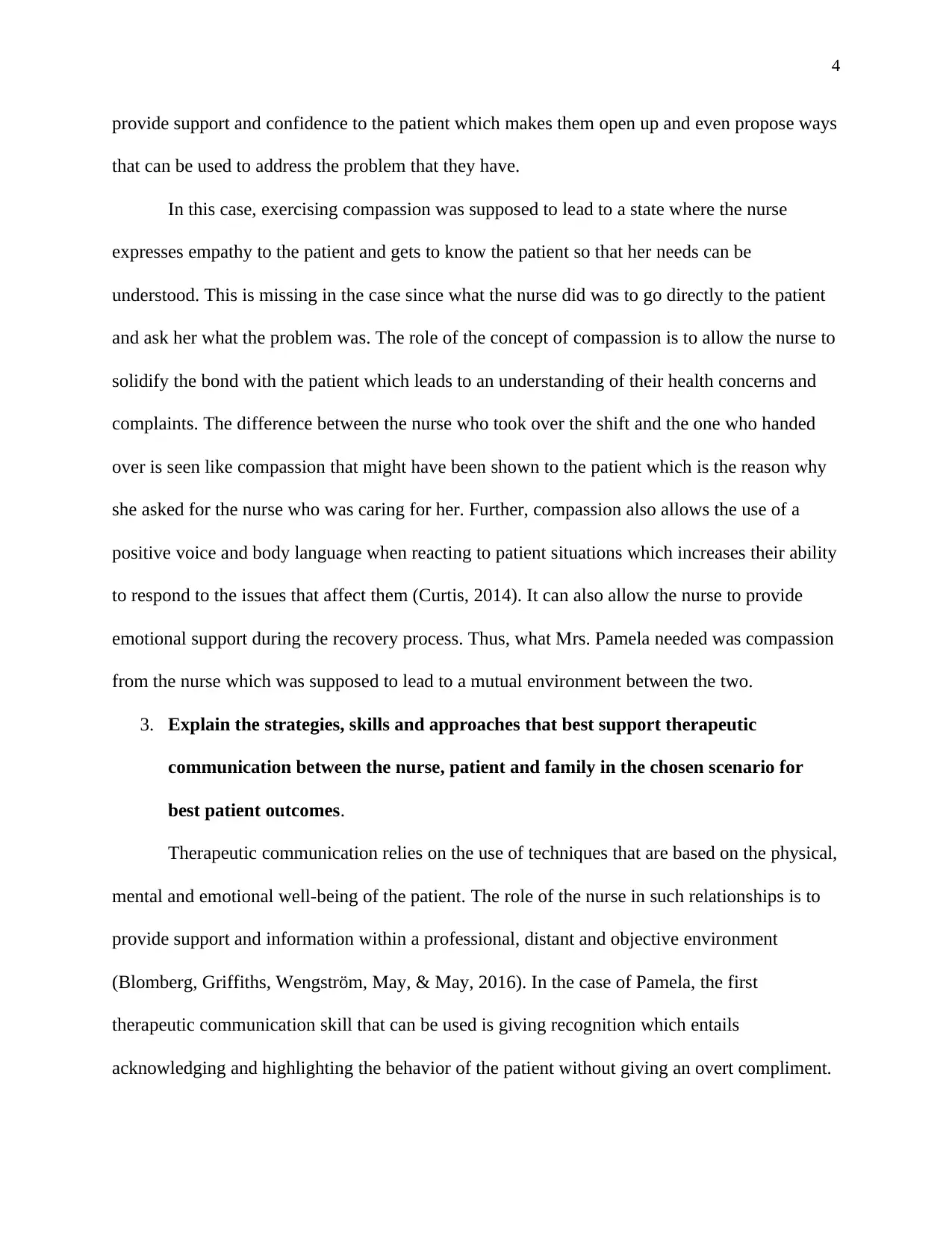
4
provide support and confidence to the patient which makes them open up and even propose ways
that can be used to address the problem that they have.
In this case, exercising compassion was supposed to lead to a state where the nurse
expresses empathy to the patient and gets to know the patient so that her needs can be
understood. This is missing in the case since what the nurse did was to go directly to the patient
and ask her what the problem was. The role of the concept of compassion is to allow the nurse to
solidify the bond with the patient which leads to an understanding of their health concerns and
complaints. The difference between the nurse who took over the shift and the one who handed
over is seen like compassion that might have been shown to the patient which is the reason why
she asked for the nurse who was caring for her. Further, compassion also allows the use of a
positive voice and body language when reacting to patient situations which increases their ability
to respond to the issues that affect them (Curtis, 2014). It can also allow the nurse to provide
emotional support during the recovery process. Thus, what Mrs. Pamela needed was compassion
from the nurse which was supposed to lead to a mutual environment between the two.
3. Explain the strategies, skills and approaches that best support therapeutic
communication between the nurse, patient and family in the chosen scenario for
best patient outcomes.
Therapeutic communication relies on the use of techniques that are based on the physical,
mental and emotional well-being of the patient. The role of the nurse in such relationships is to
provide support and information within a professional, distant and objective environment
(Blomberg, Griffiths, Wengström, May, & May, 2016). In the case of Pamela, the first
therapeutic communication skill that can be used is giving recognition which entails
acknowledging and highlighting the behavior of the patient without giving an overt compliment.
provide support and confidence to the patient which makes them open up and even propose ways
that can be used to address the problem that they have.
In this case, exercising compassion was supposed to lead to a state where the nurse
expresses empathy to the patient and gets to know the patient so that her needs can be
understood. This is missing in the case since what the nurse did was to go directly to the patient
and ask her what the problem was. The role of the concept of compassion is to allow the nurse to
solidify the bond with the patient which leads to an understanding of their health concerns and
complaints. The difference between the nurse who took over the shift and the one who handed
over is seen like compassion that might have been shown to the patient which is the reason why
she asked for the nurse who was caring for her. Further, compassion also allows the use of a
positive voice and body language when reacting to patient situations which increases their ability
to respond to the issues that affect them (Curtis, 2014). It can also allow the nurse to provide
emotional support during the recovery process. Thus, what Mrs. Pamela needed was compassion
from the nurse which was supposed to lead to a mutual environment between the two.
3. Explain the strategies, skills and approaches that best support therapeutic
communication between the nurse, patient and family in the chosen scenario for
best patient outcomes.
Therapeutic communication relies on the use of techniques that are based on the physical,
mental and emotional well-being of the patient. The role of the nurse in such relationships is to
provide support and information within a professional, distant and objective environment
(Blomberg, Griffiths, Wengström, May, & May, 2016). In the case of Pamela, the first
therapeutic communication skill that can be used is giving recognition which entails
acknowledging and highlighting the behavior of the patient without giving an overt compliment.
Paraphrase This Document
Need a fresh take? Get an instant paraphrase of this document with our AI Paraphraser
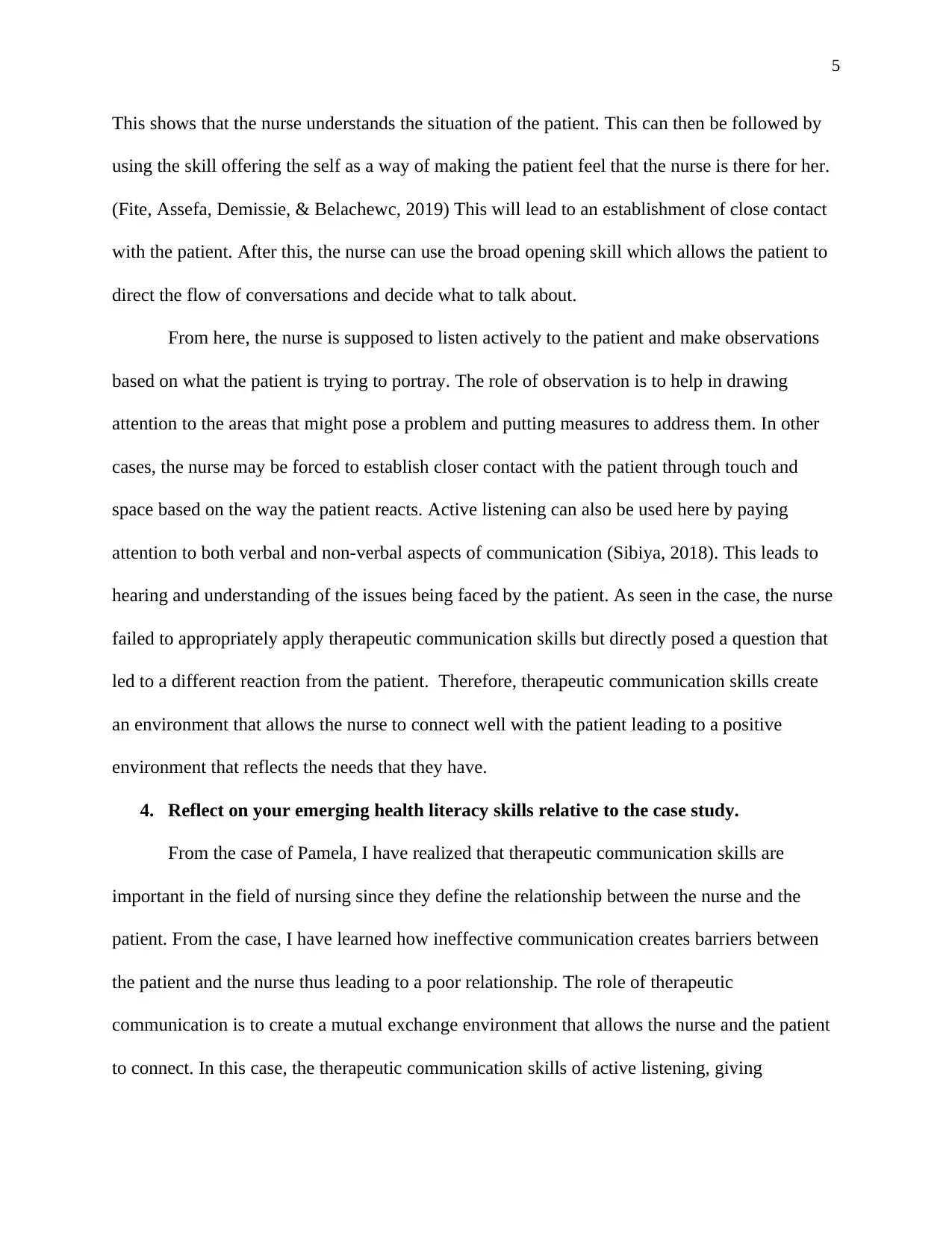
5
This shows that the nurse understands the situation of the patient. This can then be followed by
using the skill offering the self as a way of making the patient feel that the nurse is there for her.
(Fite, Assefa, Demissie, & Belachewc, 2019) This will lead to an establishment of close contact
with the patient. After this, the nurse can use the broad opening skill which allows the patient to
direct the flow of conversations and decide what to talk about.
From here, the nurse is supposed to listen actively to the patient and make observations
based on what the patient is trying to portray. The role of observation is to help in drawing
attention to the areas that might pose a problem and putting measures to address them. In other
cases, the nurse may be forced to establish closer contact with the patient through touch and
space based on the way the patient reacts. Active listening can also be used here by paying
attention to both verbal and non-verbal aspects of communication (Sibiya, 2018). This leads to
hearing and understanding of the issues being faced by the patient. As seen in the case, the nurse
failed to appropriately apply therapeutic communication skills but directly posed a question that
led to a different reaction from the patient. Therefore, therapeutic communication skills create
an environment that allows the nurse to connect well with the patient leading to a positive
environment that reflects the needs that they have.
4. Reflect on your emerging health literacy skills relative to the case study.
From the case of Pamela, I have realized that therapeutic communication skills are
important in the field of nursing since they define the relationship between the nurse and the
patient. From the case, I have learned how ineffective communication creates barriers between
the patient and the nurse thus leading to a poor relationship. The role of therapeutic
communication is to create a mutual exchange environment that allows the nurse and the patient
to connect. In this case, the therapeutic communication skills of active listening, giving
This shows that the nurse understands the situation of the patient. This can then be followed by
using the skill offering the self as a way of making the patient feel that the nurse is there for her.
(Fite, Assefa, Demissie, & Belachewc, 2019) This will lead to an establishment of close contact
with the patient. After this, the nurse can use the broad opening skill which allows the patient to
direct the flow of conversations and decide what to talk about.
From here, the nurse is supposed to listen actively to the patient and make observations
based on what the patient is trying to portray. The role of observation is to help in drawing
attention to the areas that might pose a problem and putting measures to address them. In other
cases, the nurse may be forced to establish closer contact with the patient through touch and
space based on the way the patient reacts. Active listening can also be used here by paying
attention to both verbal and non-verbal aspects of communication (Sibiya, 2018). This leads to
hearing and understanding of the issues being faced by the patient. As seen in the case, the nurse
failed to appropriately apply therapeutic communication skills but directly posed a question that
led to a different reaction from the patient. Therefore, therapeutic communication skills create
an environment that allows the nurse to connect well with the patient leading to a positive
environment that reflects the needs that they have.
4. Reflect on your emerging health literacy skills relative to the case study.
From the case of Pamela, I have realized that therapeutic communication skills are
important in the field of nursing since they define the relationship between the nurse and the
patient. From the case, I have learned how ineffective communication creates barriers between
the patient and the nurse thus leading to a poor relationship. The role of therapeutic
communication is to create a mutual exchange environment that allows the nurse and the patient
to connect. In this case, the therapeutic communication skills of active listening, giving
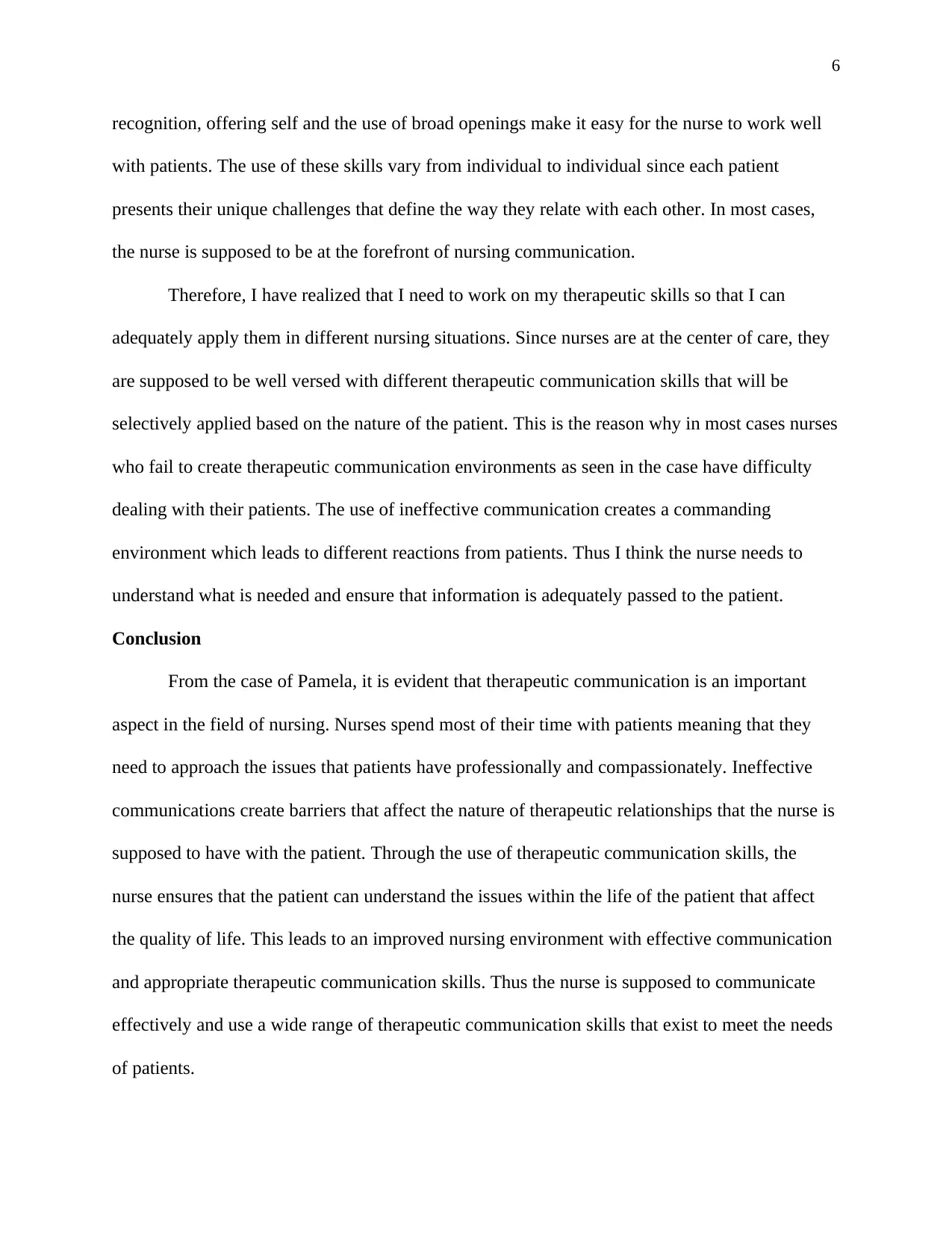
6
recognition, offering self and the use of broad openings make it easy for the nurse to work well
with patients. The use of these skills vary from individual to individual since each patient
presents their unique challenges that define the way they relate with each other. In most cases,
the nurse is supposed to be at the forefront of nursing communication.
Therefore, I have realized that I need to work on my therapeutic skills so that I can
adequately apply them in different nursing situations. Since nurses are at the center of care, they
are supposed to be well versed with different therapeutic communication skills that will be
selectively applied based on the nature of the patient. This is the reason why in most cases nurses
who fail to create therapeutic communication environments as seen in the case have difficulty
dealing with their patients. The use of ineffective communication creates a commanding
environment which leads to different reactions from patients. Thus I think the nurse needs to
understand what is needed and ensure that information is adequately passed to the patient.
Conclusion
From the case of Pamela, it is evident that therapeutic communication is an important
aspect in the field of nursing. Nurses spend most of their time with patients meaning that they
need to approach the issues that patients have professionally and compassionately. Ineffective
communications create barriers that affect the nature of therapeutic relationships that the nurse is
supposed to have with the patient. Through the use of therapeutic communication skills, the
nurse ensures that the patient can understand the issues within the life of the patient that affect
the quality of life. This leads to an improved nursing environment with effective communication
and appropriate therapeutic communication skills. Thus the nurse is supposed to communicate
effectively and use a wide range of therapeutic communication skills that exist to meet the needs
of patients.
recognition, offering self and the use of broad openings make it easy for the nurse to work well
with patients. The use of these skills vary from individual to individual since each patient
presents their unique challenges that define the way they relate with each other. In most cases,
the nurse is supposed to be at the forefront of nursing communication.
Therefore, I have realized that I need to work on my therapeutic skills so that I can
adequately apply them in different nursing situations. Since nurses are at the center of care, they
are supposed to be well versed with different therapeutic communication skills that will be
selectively applied based on the nature of the patient. This is the reason why in most cases nurses
who fail to create therapeutic communication environments as seen in the case have difficulty
dealing with their patients. The use of ineffective communication creates a commanding
environment which leads to different reactions from patients. Thus I think the nurse needs to
understand what is needed and ensure that information is adequately passed to the patient.
Conclusion
From the case of Pamela, it is evident that therapeutic communication is an important
aspect in the field of nursing. Nurses spend most of their time with patients meaning that they
need to approach the issues that patients have professionally and compassionately. Ineffective
communications create barriers that affect the nature of therapeutic relationships that the nurse is
supposed to have with the patient. Through the use of therapeutic communication skills, the
nurse ensures that the patient can understand the issues within the life of the patient that affect
the quality of life. This leads to an improved nursing environment with effective communication
and appropriate therapeutic communication skills. Thus the nurse is supposed to communicate
effectively and use a wide range of therapeutic communication skills that exist to meet the needs
of patients.
⊘ This is a preview!⊘
Do you want full access?
Subscribe today to unlock all pages.

Trusted by 1+ million students worldwide
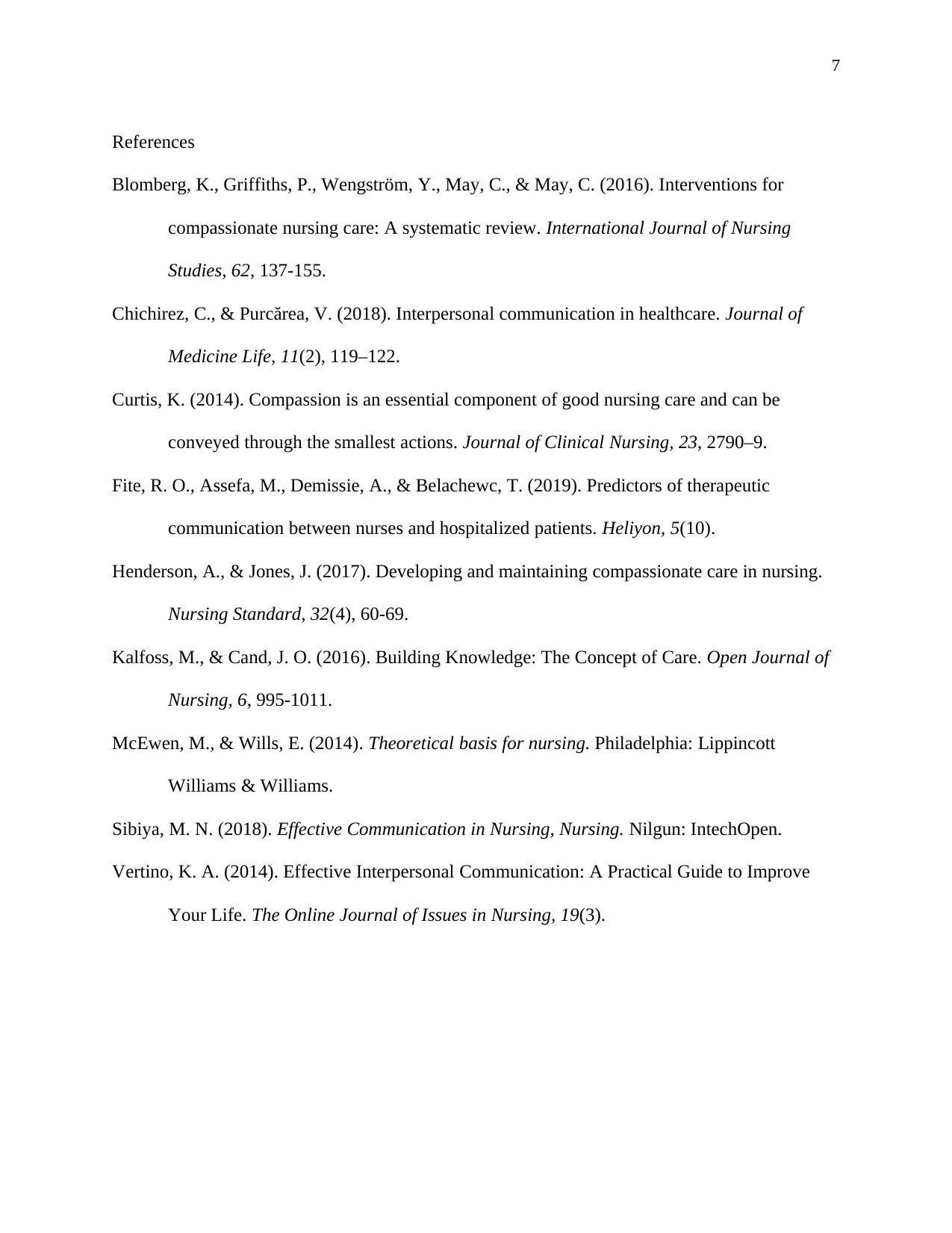
7
References
Blomberg, K., Griffiths, P., Wengström, Y., May, C., & May, C. (2016). Interventions for
compassionate nursing care: A systematic review. International Journal of Nursing
Studies, 62, 137-155.
Chichirez, C., & Purcărea, V. (2018). Interpersonal communication in healthcare. Journal of
Medicine Life, 11(2), 119–122.
Curtis, K. (2014). Compassion is an essential component of good nursing care and can be
conveyed through the smallest actions. Journal of Clinical Nursing, 23, 2790–9.
Fite, R. O., Assefa, M., Demissie, A., & Belachewc, T. (2019). Predictors of therapeutic
communication between nurses and hospitalized patients. Heliyon, 5(10).
Henderson, A., & Jones, J. (2017). Developing and maintaining compassionate care in nursing.
Nursing Standard, 32(4), 60-69.
Kalfoss, M., & Cand, J. O. (2016). Building Knowledge: The Concept of Care. Open Journal of
Nursing, 6, 995-1011.
McEwen, M., & Wills, E. (2014). Theoretical basis for nursing. Philadelphia: Lippincott
Williams & Williams.
Sibiya, M. N. (2018). Effective Communication in Nursing, Nursing. Nilgun: IntechOpen.
Vertino, K. A. (2014). Effective Interpersonal Communication: A Practical Guide to Improve
Your Life. The Online Journal of Issues in Nursing, 19(3).
References
Blomberg, K., Griffiths, P., Wengström, Y., May, C., & May, C. (2016). Interventions for
compassionate nursing care: A systematic review. International Journal of Nursing
Studies, 62, 137-155.
Chichirez, C., & Purcărea, V. (2018). Interpersonal communication in healthcare. Journal of
Medicine Life, 11(2), 119–122.
Curtis, K. (2014). Compassion is an essential component of good nursing care and can be
conveyed through the smallest actions. Journal of Clinical Nursing, 23, 2790–9.
Fite, R. O., Assefa, M., Demissie, A., & Belachewc, T. (2019). Predictors of therapeutic
communication between nurses and hospitalized patients. Heliyon, 5(10).
Henderson, A., & Jones, J. (2017). Developing and maintaining compassionate care in nursing.
Nursing Standard, 32(4), 60-69.
Kalfoss, M., & Cand, J. O. (2016). Building Knowledge: The Concept of Care. Open Journal of
Nursing, 6, 995-1011.
McEwen, M., & Wills, E. (2014). Theoretical basis for nursing. Philadelphia: Lippincott
Williams & Williams.
Sibiya, M. N. (2018). Effective Communication in Nursing, Nursing. Nilgun: IntechOpen.
Vertino, K. A. (2014). Effective Interpersonal Communication: A Practical Guide to Improve
Your Life. The Online Journal of Issues in Nursing, 19(3).
1 out of 7
Related Documents
Your All-in-One AI-Powered Toolkit for Academic Success.
+13062052269
info@desklib.com
Available 24*7 on WhatsApp / Email
![[object Object]](/_next/static/media/star-bottom.7253800d.svg)
Unlock your academic potential
Copyright © 2020–2025 A2Z Services. All Rights Reserved. Developed and managed by ZUCOL.





